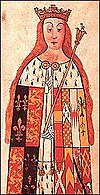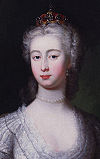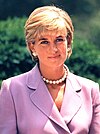Princess of Wales
| Princess of Wales | |
|---|---|
| Tywysoges Cymru | |
 | |
since 9 September 2022 | |
| Style | Her Royal Highness Ma'am |
| Member of | British royal family |
| Residence | |
| First holder | Joan of Kent |
| Website | princeofwales.gov.uk |
Princess of Wales (Welsh: Tywysoges Cymru) is a courtesy title first held by the wife of a native Prince of Wales. Since the 14th century, it has been used by the wife of the heir apparent to the English and later British throne. The current title-holder is Catherine, wife of William, Prince of Wales.[1]
Native Princesses of Wales
| Princess of Wales | |
|---|---|
| Tywysoges Cymru | |
| Inaugural holder | Eleanor de Montfort |
Origin
The native use of the title "Prince of Wales" appeared more frequent by the eleventh century as a modernised form of the old high kingship of the Britons. The Welsh had originally been the high Kings of the Britons; but the claim to be high king of late Romano-British Britain was no longer realistic after the death of Cadwaladr in 664.[2] Cadwaldr was also heavily associated with the symbol of the Red Dragon of Wales.[3][4] The princes of the medieval period hailed largely from west Wales, mainly Gwynedd. They had significant power which allowed them to claim authority beyond the borders of their kingdoms.[5]
History
The only wife of a Welsh prince definitively shown to have used the title is Eleanor de Montfort, the English bride of Llywelyn ap Gruffydd, the last native Prince of Wales. Eleanor died shortly after giving birth to their only child, Gwenllian, who was taken prisoner as an infant following her father's death. Gwenllian was the only native Welsh princess to be described as Princess of Wales; Edward I had her raised in Sempringham Priory in Lincolnshire, far from where any Welsh rebels could find her, and once appealed to the Pope to increase funds to the priory by writing that "...herein is kept the Princess of Wales, whom we have to maintain."[6]
List
| Image | Name | Birth | Spouse | Death | Notes |
|---|---|---|---|---|---|

|
Joan, Lady of Wales | 1191 | Llywelyn the Great | 2 February 1237 | Proposed to have been Princess of Wales. |
| Isabella de Braose | 1222 | Dafydd ap Llywelyn | 1248 | Proposed to have been Princess of Wales. | |

|
Eleanor de Montfort | 1252 | Llywelyn ap Gruffydd | 19 June 1282 | |

|
Elizabeth Ferrers | 1250 | Dafydd ap Gruffydd | 1300 | Proposed to have been Princess of Wales. |

|
Gwenllian of Wales | June 1282 | 7 June 1337 | Daughter of Llywelyn ap Gruffydd. Imprisoned in a priory by Edward I of England.[7] | |
| Margaret Hanmer | 1370 | Owain Glyndŵr | 1420 | Later attributed.[8] | |

|
Catrin ferch Owain Glyndŵr | Edmund Mortimer | 1413 | Daughter of Owain Glyndŵr. Abducted and imprisoned in the Tower of London by Henry IV of England.[9] |
Spouse of the British (formerly English) heir apparent
Although not granted the title in her own right, the future Queen Mary I was, during her youth, invested by her father, King Henry VIII, with many of the rights and properties traditionally given to the Prince of Wales, including use of the official seal of Wales for correspondence. For most of her childhood, Mary was her father's only legitimate heir, and for this reason, she was often referred to as "the Princess of Wales", although Henry never formally created her as such. For example, Spanish scholar Juan Luis Vives dedicated his Satellitium Animi to "Dominæ Mariæ Cambriæ Principi, Henrici Octavi Angliæ Regis Filiæ".[10]
Welsh politicians suggested Princess Elizabeth be made Princess of Wales on her 18th birthday, but King George VI rejected the idea because he felt such a title belonged solely to the wife of a Prince of Wales and the Prince of Wales had always been the heir apparent.[11]
Camilla, Charles III’s second wife, was the Princess of Wales from 2005 to 2022 but did not use the title due to its popular association with her husband's first wife, Lady Diana Spencer.[12]
List
| Person | Previous name | Birth | Marriage | Became Princess of Wales | Spouse | Change in style | Death |
|---|---|---|---|---|---|---|---|

|
Joan of Kent | 19 September 1328 | 10 October 1361 | Edward of Woodstock | 7 June 1376 (husband's death) |
7 August 1385 | |

|
Anne Neville | 11 June 1456 | 13 December 1470 | Edward of Westminster | 4 May 1471 (husband's death) |
16 March 1485 | |

|
Catherine of Aragon | 16 December 1485 | 19 May 1499 (by proxy) 14 November 1501 |
Arthur Tudor | 2 April 1502 (husband's death) |
7 January 1536 | |

|
Caroline of Brandenburg-Ansbach | 1 March 1683 | 22 August 1705 | 27 September 1714 | George Augustus | 11 June 1727 (husband's accession as George II) |
20 November 1737 |

|
Augusta of Saxe-Gotha-Altenburg | 30 November 1719 | 17 April 1736 | Frederick Louis | 31 March 1751 (husband's death) |
8 February 1772 | |

|
Caroline of Brunswick-Wolfenbüttel | 17 May 1768 | 8 April 1795 | George Augustus Frederick | 29 January 1820 (husband's accession as George IV) |
7 August 1821 | |

|
Alexandra of Denmark | 1 December 1844 | 10 March 1863 | Albert Edward | 22 January 1901 (husband's accession as Edward VII) |
20 November 1925 | |

|
Mary of Teck | 26 May 1867 | 6 July 1893 | 9 November 1901 | George Frederick Ernest Albert | 6 May 1910 (husband's accession as George V) |
24 March 1953 |

|
Diana Spencer | 1 July 1961 | 29 July 1981 | Charles Philip Arthur George | 28 August 1996 (divorced) then titled Diana, Princess of Wales |
31 August 1997 | |

|
Camilla Shand[13] | 17 July 1947 | 9 April 2005 | 8 September 2022 known as Duchess of Cornwall (husband's accession as Charles III) |
living | ||

|
Catherine Middleton | 9 January 1982 | 29 April 2011 | 9 September 2022 | William Arthur Philip Louis | Incumbent | living |
See also
- Movement to end the Prince of Wales title
- The Green Howards (Alexandra, Princess of Wales's Own Yorkshire Regiment)
- The Princess of Wales' Own Regiment (Canada)
Notes
- ^ "King Charles III pays tribute to his 'darling mama' in first address". BBC.com. 9 September 2022.
- ^ Kessler, P. L. "Kingdoms of Cymru Celts – Wales / Cymru". www.historyfiles.co.uk. Retrieved 26 July 2022.
- ^ Hughes, Jonathan, "Politics and the occult at the Court of Edward IV", Princes and Princely Culture: 1450–1650, Brill, 2005, pp. 112–113.
- ^ D.R. Woolf, "The power of the past: history, ritual and political authority in Tudor England", in Paul A. Fideler, Political Thought and the Tudor Commonwealth:Deep Structure, Discourse, and Disguise, New York, 1992, pp. 21–22.
- ^ "Kings and Princes of Wales". Historic UK. Retrieved 28 July 2022.
- ^ Bliss, W. H., editor. Calendar of Papal Registers Relating To Great Britain and Ireland: Volume 1, 1198-1304. Her Majesty's Stationery Office, London, 1893.
- ^ "Gwenllian The Lost Princess of Wales". Historic UK. Retrieved 11 September 2022.
- ^ Deborah Fisher, Princesses of Wales (University of Wales Press, 2005)
- ^ Issues of the Exchequer, Hen. III – Hen. VI, ed. F Devon (Record Commission, 1837), p. 327
- ^ "To the Lady Mary, Prince of Wales, Daughter of Henry VIII, King of England" [1]
- ^ Pimlott, Ben (2001). The Queen: Elizabeth II and the monarchy (Golden Jubilee ed.). London: HarperCollins. ISBN 0-00-711435-4. OCLC 59496079.
- ^ "House of Commons – Royal Marriage". parliament.uk. Retrieved 7 February 2015.
- ^ Chris Leslie, Parliamentary Secretary, Department for Constitutional Affairs (4 April 2005). "Royal Marriage". Parliamentary Debates (Hansard). United Kingdom: House of Commons. col. 1228W.
Bibliography
- Princesses of Wales by Deborah Fisher. University of Wales Press, 2005.
- 'Tystiolaeth Garth Celyn' Y Traethodydd 1998 ISSN 0969-8930
Further reading
- Fryer, M.; Mary Beacock Fryer; Arthur Bousfield; Garry Toffoli (1983). Lives of the Princesses of Wales. Toronto: Dundern Press Limited. ISBN 978-0-919670-69-3.


